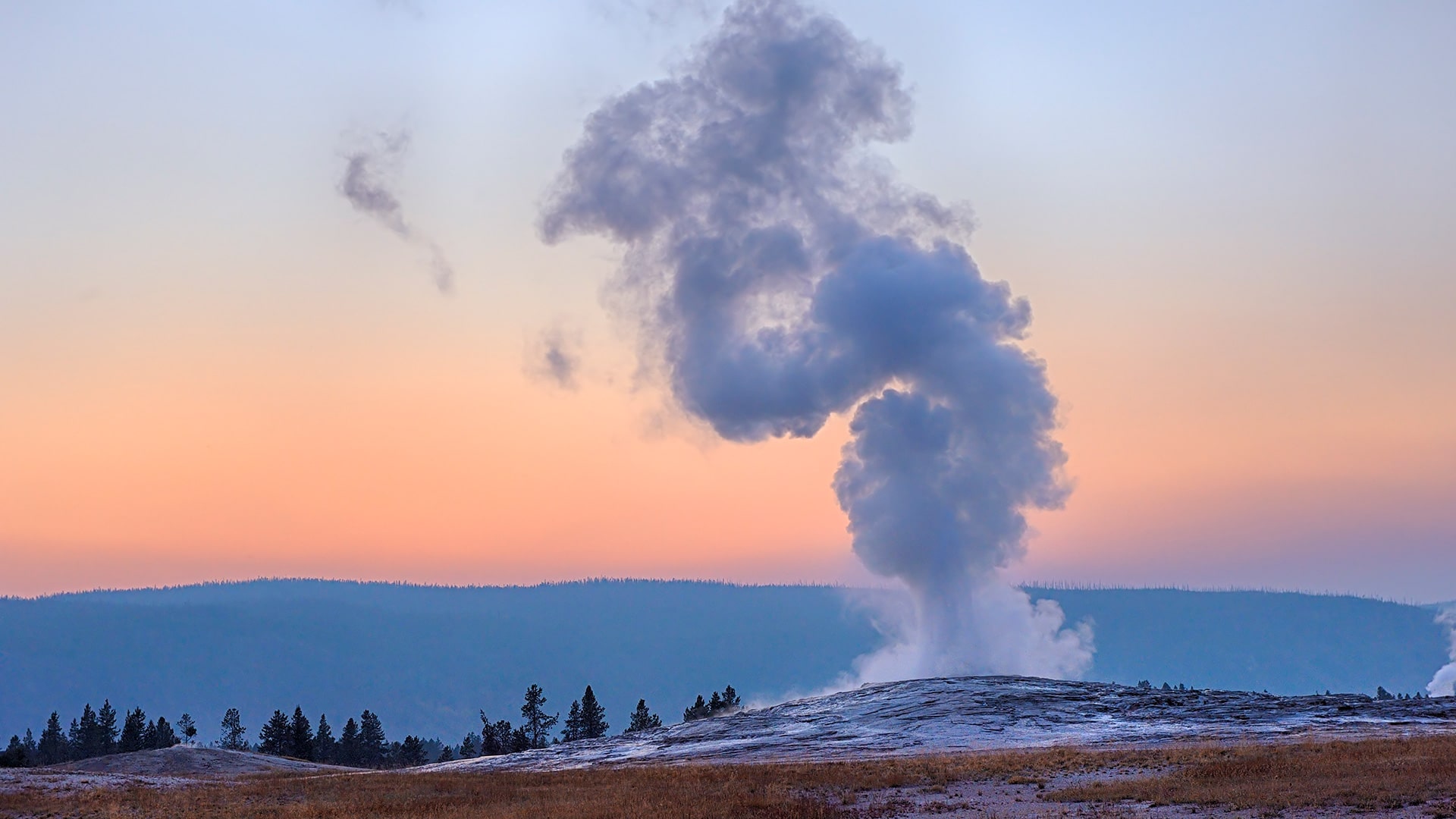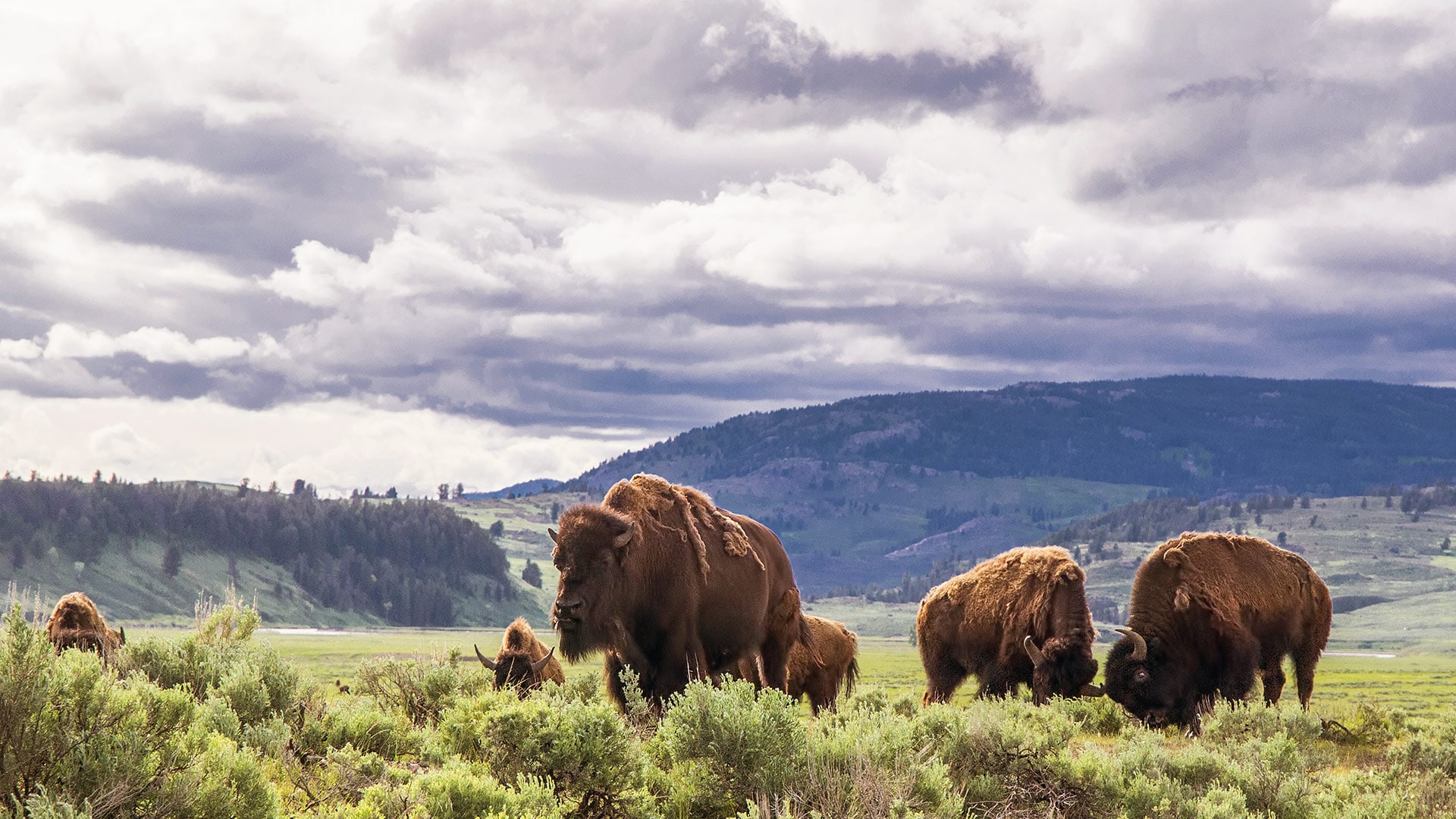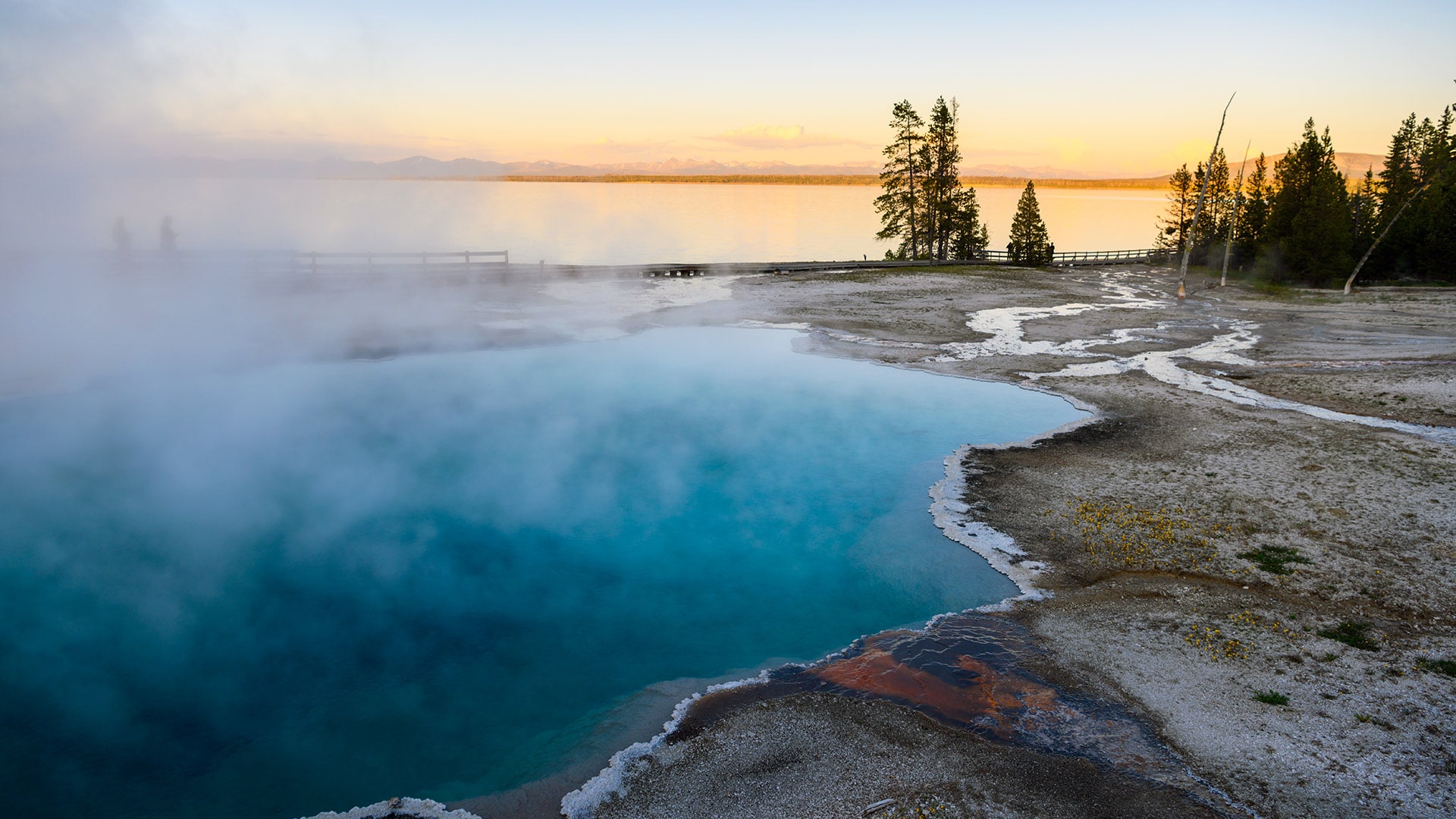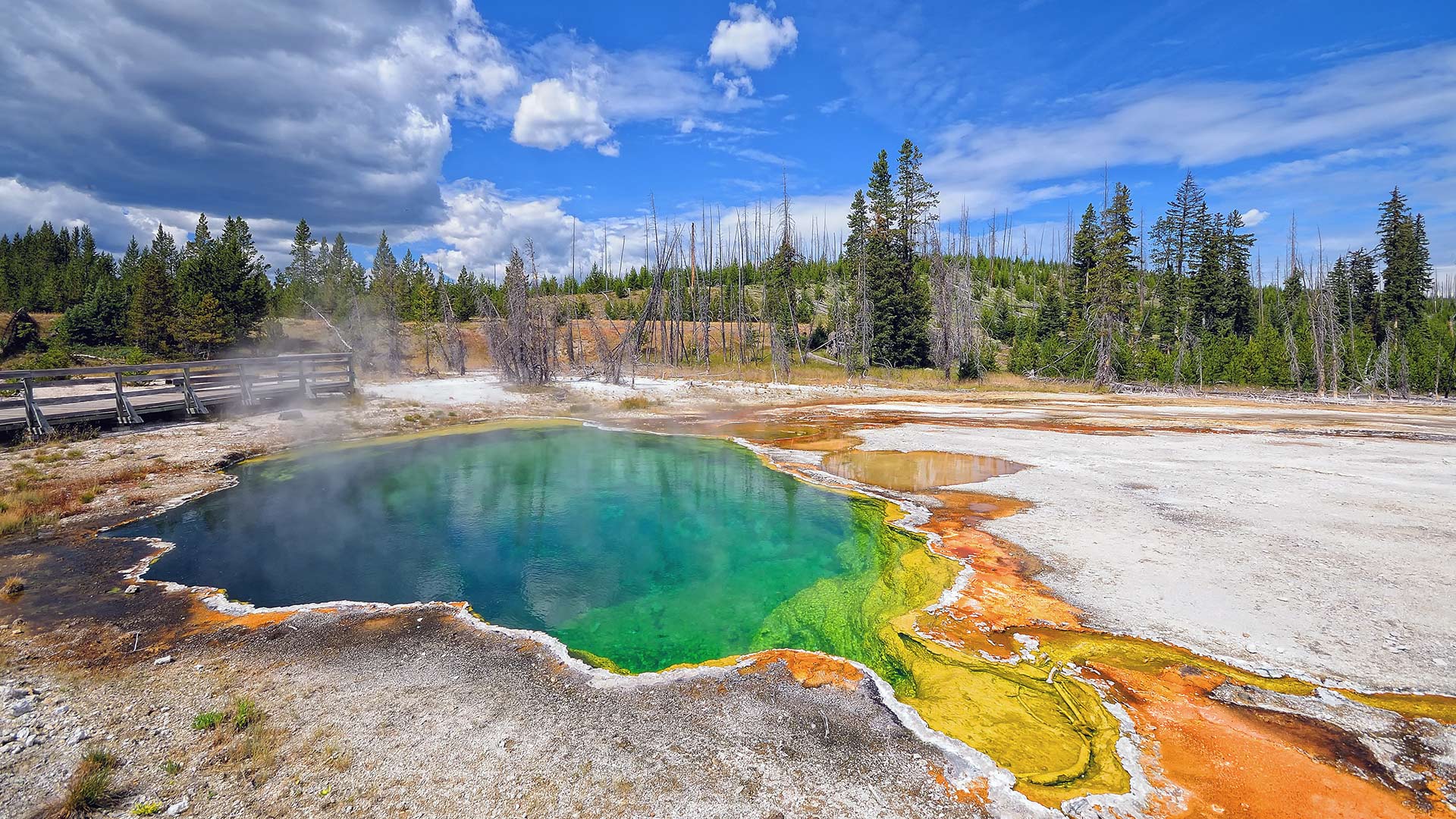Spanning nearly 3,500 square miles, Yellowstone National Park is larger than Delaware and Rhode Island combined. This sprawling, awe-inspiring expanse of land is home to half the world’s hydrothermal features. Geysers, mud pots and hot springs are powered by a massive volcanic hot spot, where molten magma swirls and gurgles deep beneath the earth.
Combine those geothermal wonders with glaciers, granite peaks and 4,000-foot-wide canyons and the landscape seems almost otherworldly. In fact, when John Colter of the Lewis and Clarke expedition stumbled upon Yellowstone in the early 19th century and returned to share his discovery, no one believed his tales, leading to the nickname “Colter’s Hell,” a so-called fantasyland.
Yellowstone National Park could take a lifetime to explore, but it’s also possible to see the best the area has to offer over a three-day weekend. Keep in mind, the park is primarily a spring and summer destination, and while you can go to Yellowstone any time of the year, roads and restaurants may be closed in the colder months.
As always, check for travel guidelines and closures before planning your trip.
Friday: See Geysers in All Their Glory
During your three-day trip, you might not have time to visit all 10,000 of Yellowstone’s geothermal wonders. But today, you’ll get a sense of the spurts, explosions and gurgles that have been wowing visitors for hundreds of years.
Set your alarm for the wee hours and make sure your water bottles are filled and your cooler is packed the night before. The park is expansive, and food and drink options are few and far between, so you’ll want to have everything you need before setting out for the day — the same rule applies throughout the weekend.
Pro tip: While you’re still in cellphone range, download the National Park Service Yellowstone App. This will come in handy later.

Get to Old Faithful just after sunrise to see the park’s most famous geyser put on a show before the crush of late-morning crowds. Your Yellowstone app will predict the regular (aka “faithful”) eruptions that occur every 90 minutes or so. Secure a spot on the viewing deck and watch 8,400 gallons of scalding-hot water shoot 180 feet up into the air.
After the blow, embark on your first hike of the day: the 2.5-mile Geyser Hill Loop Trail. The mellow trail circles Old Faithful along a raised boardwalk before taking visitors by multiple lesser-known features, including Beehive Geyser, Lion Geyser and the vividly turquoise waters of Blue Star and Ear Springs.
Hop back in the car, eat a packed lunch on the way and drive on Highway 59 toward the Fairy Falls Trail parking lot (about 6 miles north).
Along the route, pull over to take a look at Black Sand Basin (obsidian sand and jewel-colored waters), Morning Glory Pool (steaming hot yellow and green waters) and Biscuit Basin Geyser (a 0.6-mile lollipop loop circling a number of volatile features).
Once at Fairy Falls Trail, trade spouting waters for cascading falls. The 4.8-mile out-and-back hike winds through a thickly wooded pine forest. The route is mostly flat, but the offshoot up to Grand Prismatic Overlook includes a heart-pounding hill and a bird’s-eye view of the Grand Prismatic Spring. At the turnaround, enter the splash zone at the 200-foot-tall cataract.
Back in the car, continue north to Firehole River. Stake your claim on a table with a serene river view and end the day with a relaxing picnic dinner. Stay for sunset if you don’t mind driving back to your digs in the dark. The splash of colors across the sky at Firehole is particularly spectacular.
Saturday: Set Out to Find the Park’s Wildlife

In a park famous for bison traffic jams, the wildlife may well come to you as you’re exploring Yellowstone. But if you want the very best chance of seeing the area’s majestic mammals in their natural habitat, Lamar Valley is a must.
More good news for early birds: Some of the best wildlife viewing happens within a few hours after sunrise.
If you’re heading into the park from the west side, pack your binoculars, swimsuit and towel, and stop at Running Bear Pancake House in West Yellowstone. The homestyle diner opens at 6 a.m. sharp and serves up stick-to-your-ribs chicken-fried steak and cinnamon-roll pancakes. Order a few “Running Bear Box Lunches” to go for later and hit the road for a 70-mile drive east through the park.
Once in Lamar Valley, prepare to be amazed by the magnitude and diversity of wildlife. Yellowstone boasts the largest concentration of mammals in the lower 48, and you’re likely to see bison, pronghorn antelope, grizzly bears, badgers, coyotes and bighorn sheep — and maybe even wolves, if you’re lucky.
If you want to view animals from outside the comfort of your car, hike on the Lamar River Trail. The trail extends for 33 miles, so just go out-and-back for as long as you like. Come springtime, the fields fill with wildflowers. All times of year, keep your eyes out for bears — you wouldn’t be remiss to pack bear spray, and make plenty of noise by talking or singing as you hike.
Back in the car, make your way half an hour west to Tower Fall. This easily accessible natural stunner is visible just 100 yards from the parking area. Dig in to your boxed lunch as you watch the stunning feature plunge 132 feet into Tower Creek.
Continue northeast on Grand Loop Road, stopping at the Petrified Tree, a redwood preserved in time after a chain of volcanoes erupted 50 million years ago, and the Hellroaring Trailhead, where you can take a 2-mile hike to cross a steel suspension bridge, constructed in 1935 to span the Yellowstone River.
In another 16 miles, you’ll hit Boiling River Hot Springs — the final attraction for the day. Located where hot springs converge with the Gardner River, this is one of the only places in the park where you can safely (and legally) submerge yourself in the geothermally heated waters. Relax in pockets of hot and cool water as you watch steam rise from the surrounding riverbeds.
For dinner, drive 4 miles north to Gardiner, Montana, for nachos and a triple taco plate at Mountain Tacos before you call it a night.
Sunday: Get Out on a Glacial Lake
Today, you’ll enjoy another one of Yellowstone’s superlatives: The park is home to North America’s largest high-alpine lake. If you’re staying in the gateway city of Island Park, Idaho, grab breakfast at your hotel — SpringHill Suites by Marriott Island Park Yellowstone has great options — or TroutHunter Last Chance Bar and Grill for thickly sliced French toast topped with fresh huckleberries.

Drive into Yellowstone, making your first stop at West Thumb Geyser Basin. One of the first geothermal formations ever to be covered in a national newspaper, a Yellowstone trapper in 1827 described the wonder to the “Philadelphia Gazette,” writing that the “clay is white and of a pink and water appears fathomless… entirely hollow underneath.”
Next drive, 25 miles northeast to Bridge Bay Marina, where you can rent an inboard, outboard or a rowboat, if you prefer to let your arms do the motoring. Set out for a cruise around stunning Yellowstone Lake. With 141 miles of shoreline, there’s plenty to explore.
Swimming isn’t recommended — waters reach only 40 degrees Fahrenheit in the summer months — but you can spend a few hours unwinding on the lake or trying your luck fishing for cutthroat trout.
Find a lakeside restaurant for lunch before paying a visit to Bill Cody Ranch, about 55 miles east of the marina. A two-hour guided trail ride will take you through the stunning Shoshone National Forest, along mountain passes in the Wyoming wilderness.
If you still have time before sunset, drive back west to Avalanche Peak. Embark on a short mile-long hike up to the bowl of the peak and watch the sky’s colors swirl as the sun sets beyond the Absaroka Mountains before you turn back down the trail, lit by the alpine glow.
For dinner, Beartooth BBQ in West Yellowstone is a classic choice. Tuck into a tray of sliced beef brisket, cowboy caviar and green-chile creamed corn. Cheers to a weekend well spent with one of the dozen or so frosty local beers on tap.




